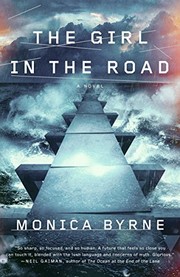A tale of slavery, sexual violence, and prejudice set in the nearish future.
5 stars
This was Monica Byrne's debut novel and wow! She doesn't screw around!
This is the gripping tale of a climate-tipping-point future where India has much more economic clout in the world, and is expanding its power and influence (with China) into Africa. Among many interesting technologies that have been developed, a huge wave-energy power generator has been constructed from India to Africa, consisting of a long chain of floating inverted pyramids, each about a metre square, which form a road between continents; the 'Trail'. Although it's illegal to walk on, travellers do it anyway.
Meena is one such traveller, who is fleeing something in India, although we don't know the details, only that she's got snake bites on her chest, she's fled her home, and is totally paranoid about being followed.
We learn that she's an orphan raised by the parents of her doctor father, who was brutally murdered, along with his pregnant wife, in a hospital in Ethiopia. Meena was the only survivor, and now that she's fleeing, she decides to head back to Ethiopia via the Trail, in order to find her parents' murderer.
Meanwhile, Mariama is an escaped slave girl heading to Ethiopia from Western Africa. She attaches herself to a convoy of trucks heading East, as does a motherly woman she becomes obsessed with and begins to worship like some kind of divine avatar. We learn much of this future Africa, and the world, through Miriama's wide eyed ignorance.
So we have two 'girls' ostensibly heading to the same destination, who seem to have some kind of mystical connection. They both clearly traumatised and suffer mental illness. I think this and Byrne's The Actual Star are the only two Sci Fi novels I've read that has protagonists who are truly, certifiably, fucked up in such a realistic, tragic way. The violence and trauma become progressively less implied and metaphorical, and more literal and graphic.
There is so much beauty in this book, and so much trauma and madness that it's overwhelming. Despite the slavery, sexual violence, and prejudice mentioned throughout the story, the final terrible twists are still jarring. But in a good way; not a soft story, but a compelling one.

